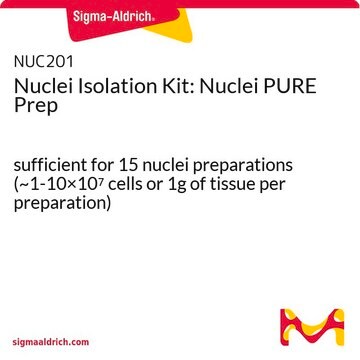CS0760
Isolated Mitochondria Staining Kit
1 kit sufficient for 50 reactions (in a 2 mL cuvette), 1 kit sufficient for 1000 reactions (using 96 multiwell plates)
About This Item
Productos recomendados
Quality Level
usage
kit sufficient for 1000 reactions (using 96 multiwell plates)
kit sufficient for 50 reactions (in a 2 mL cuvette)
packaging
pkg of 1 kit
storage condition
dry at room temperature
technique(s)
flow cytometry: suitable
protein staining: suitable
fluorescence
λex 490 nm; λem 590 nm (JC-1 dye)
application(s)
cell analysis
detection
detection method
fluorometric
shipped in
dry ice
storage temp.
−20°C
Categorías relacionadas
Application
Features and Benefits
- Fast, simple, and convenient method for staining isolated mitochondria and for assaying mitochondria intactness
- Contains all the reagents required for the detection of changes in mitochondrial inner-membrane electrochemical potential
- Contains the antibiotic Valinomycin that permeabilizes the mitochondrial membrane, and thus, dissipates the mitochondrial electrochemical potential. Valinomycin can be used as a control agent that prevents JC-1 aggregation
Principle
Analysis Note
Solo componentes del kit
- DMSO 1 mL
- JC-1 Assay Buffer 5X 25 mL
- JC-1 Stain 25 μg
- Valinomycin Ready Made 100 μL
related product
signalword
Danger
hcodes
Hazard Classifications
Acute Tox. 1 Dermal - Acute Tox. 1 Oral
Storage Class
6.1A - Combustible acute toxic Cat. 1 and 2 / very toxic hazardous materials
flash_point_f
Not applicable
flash_point_c
Not applicable
Certificados de análisis (COA)
Busque Certificados de análisis (COA) introduciendo el número de lote del producto. Los números de lote se encuentran en la etiqueta del producto después de las palabras «Lot» o «Batch»
¿Ya tiene este producto?
Encuentre la documentación para los productos que ha comprado recientemente en la Biblioteca de documentos.
Los clientes también vieron
Artículos
Cellular apoptosis assays to detect programmed cell death using Annexin V, Caspase and TUNEL DNA fragmentation assays.
Cellular oxidative stress is countered by enzymatic scavengers and antioxidant modulators against reactive oxygen species damage.
Nuestro equipo de científicos tiene experiencia en todas las áreas de investigación: Ciencias de la vida, Ciencia de los materiales, Síntesis química, Cromatografía, Analítica y muchas otras.
Póngase en contacto con el Servicio técnico










